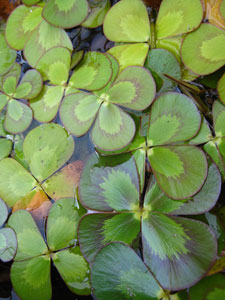Resource Library
Plant of the Week: Water Clover
The University of Arkansas System Division of Agriculture does not promote, support or recommend plants featured in "Plant of the Week." Please consult your local Extension office for plants suitable for your region.
Plant of the Week
Water Clover
Latin: Marsilea mutica

Say the word fern and people instantly conjure images of a green, feathery plant that is, well, ferny. But of course, the typical ferny leaf is but one body design used in this ancient and extremely variable group of plants. One of the oddball ferns, the water clover (Marsilea mutica), looks like your typical lucky four-leaf clover but in fact is one of the older fern species.
Water clover - also called banded nardoo, an Aboriginal name for these plants in its native Australia - is a mud-growing aquatic fern in the Salviniales section of the fern group. This section consists of five families of aquatic ferns, two of which are free-floating plants and three are mud dwellers along banks or in shallow water.
The Salviniales are united as a group because they produce two types of spores: a small male spore and a large female spore. Typically ferns produce a single, unisex spore that gives rise to both male and female gametes during the fertilization process. Evolutionarily water ferns are an ancient group found in both hemispheres and on all continents (except Antarctica), and probably date back at least 300 million years, about when the supercontinent Pangaea began to separate into the earth's northern and southern land masses.
Water clover produces long, freely branching rhizomes that spread the plant along the mud in sunny spots at the edge of a stream or lake or in shallow water up to about 18 inches deep. At each node, it produces a leaf on a slender rachis, which terminates in a floating frond. The frond is about 2 inches across with four pinna (leaflets) that are of equal size. A brown line bisects each pinna in an irregular line about a third of the way down the length of the leaflet. Close inspection of the frond will reveal the familiar veination pattern seen in other ferns.
The floating fronds are sterile and never produce spores. Spores typically only form when the mud hole, where the plant grows, dries up. Then they are produced in a hard, brown structure one-third of an inch long called a sporocarp. These sporocarps are designed to see the plant through droughts, with some species known to remain viable for up to 100 years.
Water clover has an interesting history of human interaction. Like many other plants, it is edible if you know how to prepare it, but do it wrong and it will kill you. The Aborigines in Australia's outback learned to make a thin, watery gruel by grinding the sporocarps. The spores are encased in a water-absorbent starch matrix (a natural equivalent to the water absorbent polymers used in modern diapers) which expands many times its size when in contact with water.
The first team of white Australians to attempt to cross the outback in 1860 found themselves out of provisions and nearly out of water. Friendly Aborigines showed them how to prepare nardoo (Marsilea drummondii), the water fern that grows in that part of the Australia. But instead of making the recommended gruel, the Englishmen made a kind of flapjack. Because the expansion of the starch left them feeling satisfied after even a small meal, they thought all was good until they started dying. It turns out water ferns have an enzyme that breaks down thiamine (vitamin B1), so two of the three explorers died of beriberi because they ate the spores in a too-concentrated dose.
Banded water clover is the most common of the water ferns offered for sale by water garden suppliers. It is hardy through at least zone 7 and perhaps will survive even further north. It cohabits nicely in sunny water gardens with water lilies and other water plants and doesn't seem especially aggressive or extremely finicky in its preferences. Propagation is by division in the spring. This species has been reported as escaped in Maryland and is banned from sale in Oklahoma.
By: Gerald Klingaman, retired
Extension Horticulturist - Ornamentals
Extension News - November 12, 2010
The University of Arkansas System Division of Agriculture does not maintain lists of retail outlets where these plants can be purchased. Please check your local nursery or other retail outlets to ask about the availability of these plants for your growing area.